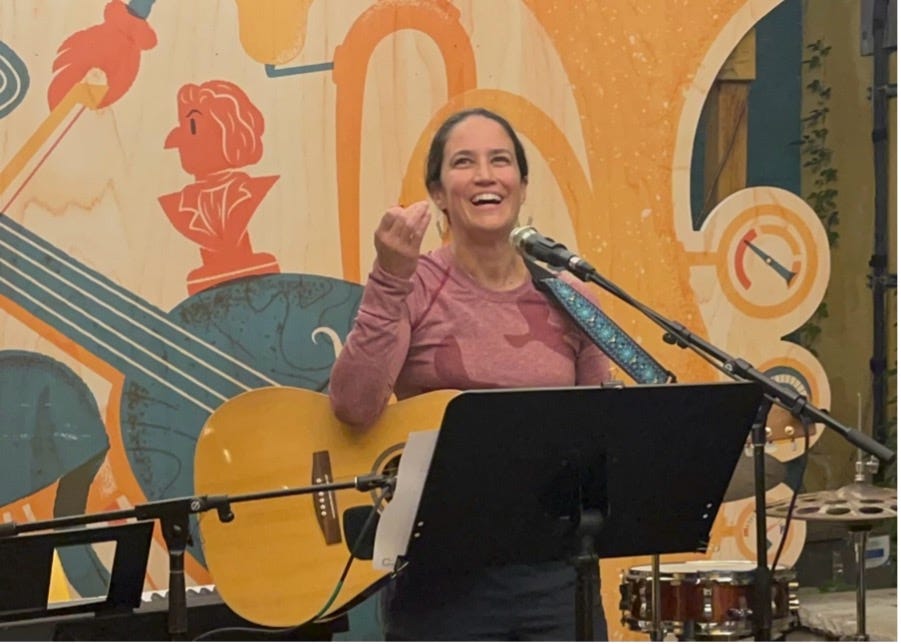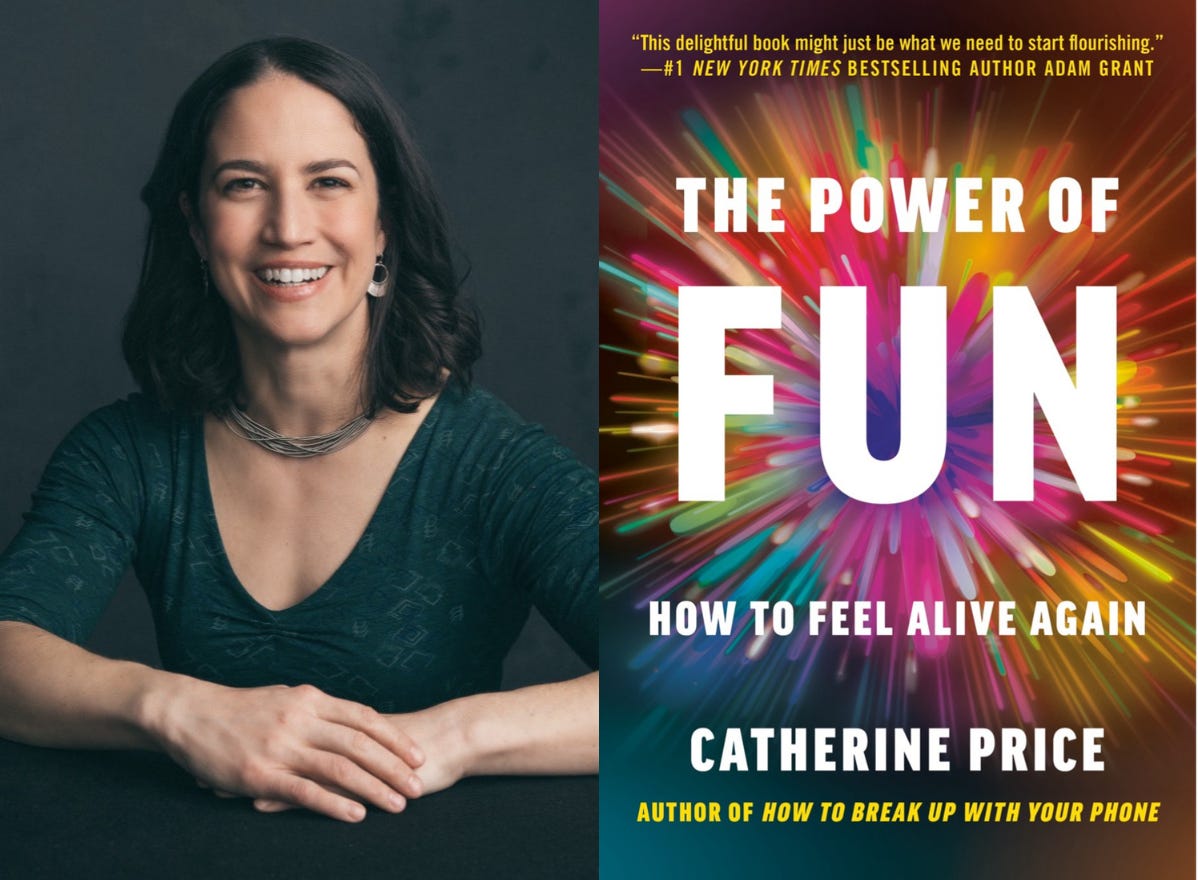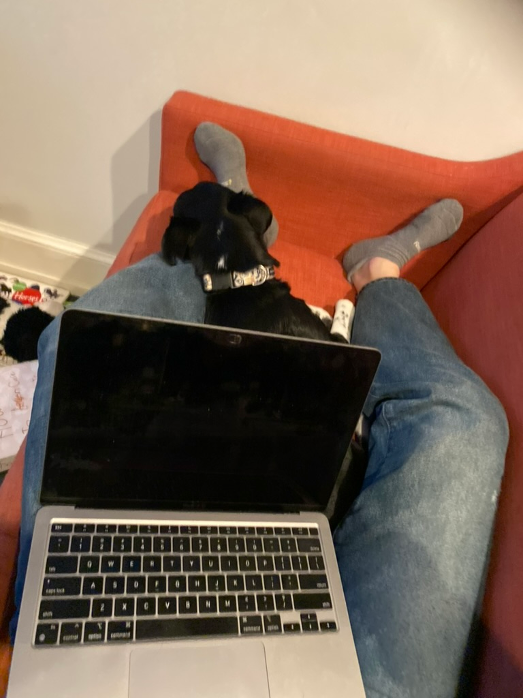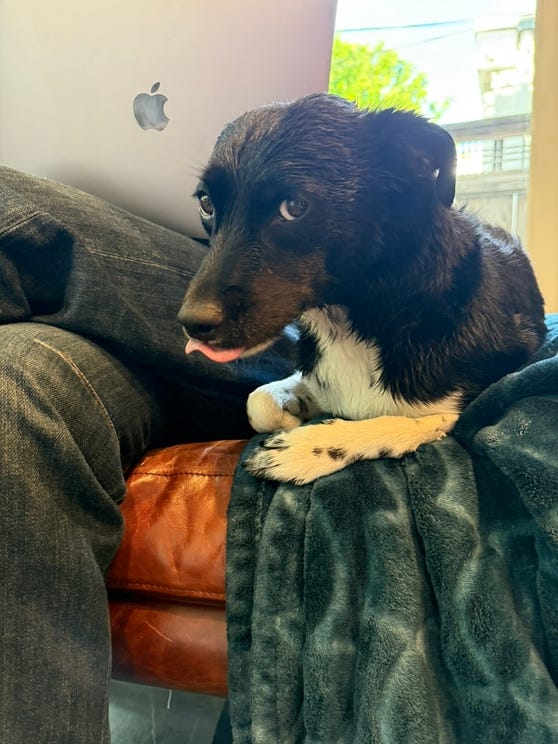The Serious Business of Fun
Catherine Price answers 20 questions about creativity, phones, and finding joy beyond our screens.
Catherine Price has spent her career exploring how our daily choices shape the quality of our lives. An award-winning journalist and bestselling author, she’s written How to Break Up With Your Phone and The Power of Fun: How to Feel Alive Again, books that challenge the way we relate to our devices and remind us of the importance of joy. Her next, The Amazing Generation (co-authored with Jonathan Haidt), is aimed at tweens and teens, offering guidance on how to resist the pull of smartphones and social media.
Alongside her books, Catherine runs How to Feel Alive, her Substack newsletter and podcast, and founded Screen/Life Balance, a project dedicated to helping people reclaim their attention and time. Her TED talk on fun has been viewed more than 5 million times, and she speaks to audiences everywhere, from Fortune 500 companies to schools and community groups. Whether on the page, on stage, or in her inbox, her mission is consistent: to help people spend less time scrolling and more time truly living.
Below, she shares candid reflections on the writing life—mixing humor, practicality, and a reminder that fun deserves a place in the process, too.
20 Questions with Catherine Price
1. I couldn’t have written my last book without…
My husband, my dog, and my best friend from journalism school. They’re my emotional support animals.
2. What’s the thing most people get wrong about being a writer?
I think one of the biggest things they get wrong, at least about being a freelance nonfiction writer, is that writers spend the majority of their time writing. Instead, a lot of time is spent trying to convince people to let you write—I’ve spent a horrifying amount of time crafting cold email pitches to editors I’ve never met. I switched over to writing books in part because I was so tired of constantly pitching. It’s much nicer to only have to sell one idea every few years.
3. Hemingway wrote standing up; Edith Wharton, lying down. What are your quirks?
I write on a small laptop, often on the couch with my computer propped on my dog (she likes to cuddle). It is extremely un-ergonomic.
4. Kiss, marry, kill: podcasts, newsletters, and speaking gigs.
I actually like all three. I love writing my Substack newsletter, “How to Feel Alive,” but writing can be very isolating, so I seek out opportunities to connect and have conversations with people whenever I can.
5. Have any tech tools made your job easier?
I’ve started using Descript, the video and audio editing tool, to edit podcast interviews and video clips, and for transcription. I also use Scrivener to keep track of ideas, writing, and research when I’m working on book projects.
6. What new tools or distribution channels do you want to try?
Oh, God, I don’t want to try any new distribution channels, at least not online. I’m hungry for more human connection, not more apps.
7. Where do you find new ideas?
I try to notice things that I’m personally struggling with or am curious about and then turn them into essays or projects. For example, the idea for How to Break Up With Your Phone came to me shortly after my daughter was born, when I noticed that I was spending more time on my phone than I wanted to. I couldn’t find a book that offered a solution, so I decided to write one.
The Power of Fun was the result of me having a ton of fun in a guitar class (which I’d signed up for as a result of spending less time on my phone). I got curious about the true definition of “fun,” and what having fun might be doing to me physically. I couldn’t find good answers, so I decided to turn that into a book project, too.

8. How do you keep track of new ideas?
I keep a written journal for thoughts, ideas, and observations, and I have a notebook titled “Obsessive Lists” that I use to keep track of to-dos (and “have-dones”). I also sometimes jot down ideas in the Notes app on my phone, as well as in random Google Docs that promptly get lost in my Google Drive, never to be seen again.
9. What’s the best piece of professional advice you’ve ever received?
I had a history professor in college who believed in what he called “creative drift”: the idea that the most rewarding way to live is to do your absolute best at the task at hand and trust that opportunities will emerge as a result—often opportunities that you never could have anticipated, and that wouldn’t have presented themselves if you’d taken a more linear route. That’s how I’ve tried to approach my own career.
10. And the worst?
Write for free in exchange for “exposure.” With very few exceptions, this has never been worth it.
11. What is the one piece of advice you would give to recent graduates who want to make a living as a writer?
Figure out another source of income! Seriously. It was hard to make a living as a writer when I started out in the early 2000s, and it’s even harder now — I don’t know how someone starting a career as a freelance writer could possibly make enough to support themselves these days through writing alone. The more income streams you can create for yourself, the better.
12. What’s the most effective way you’ve found to build your email list?
I’ve used a variety of strategies. One that’s been particularly effective is to create “lead magnets” like resource guides, toolkits, or quizzes based on my books, which I send to people for free when they sign up for my list. Another is to collaborate with other writers on Substack, whether through Substack lives, interviews, or guest posts. That’s one of the things I love the most about Substack, actually: it makes it really easy for writers to share each other’s work.
13. How are you using social media to grow your audience?
For years, I didn’t use social media at all—and I still have no desire to spend time looking at it, let alone post videos of myself dispensing life advice as I eat breakfast. These days, I use social media as a tool to amplify content and ideas that I think are valuable, to elevate other people’s work, and to reach more people who might be interested in reading my books or newsletter. While I think that having a large following can create an impression of professional legitimacy, I haven’t found that it does much in terms of book sales or even newsletter subscriptions.
14. How many drafts before you show your editor?
I’ve had different editors for each of my books, and each relationship has been different. But in general, I go through a lot of drafts before I share the manuscript with my editor—to the point that I don’t think in terms of drafts at all. Instead, I just save my manuscript as a new file every day.
I’m very careful about when I ask people for feedback, because if it’s too early, it’s a waste of my readers’ time, and it can also derail my own creative process. When I feel like I’ve gotten as far as I can myself—or get stuck, or have an issue I can’t solve—I share material with my husband and one or two trusted friends whom I know are willing to take the time necessary to really engage with the manuscript and help me work through big picture thoughts and structural challenges. (This type of editing takes a lot of work—I probably should be paying them!) Sometimes, I ask them to add comments directly to the document, but a lot of my “editing” process actually happens through conversations. I find talking through things to be enormously helpful.
Then, once I’m at a point where I feel good about the manuscript myself, I send it to my editor (often with specific questions I want their take on, and sections flagged where I know I need help). But that’s not the end of my own process, either, because within 1-2 days after sending it in, I end up looking at the manuscript again myself and deciding that it’s inherently flawed. So I rip it apart, make major cuts and structure changes, and go through multiple “drafts” more before showing it to my editor again . . . and then the cycle continues.
15. Can you describe your ideal workday?
I’d get up an hour before my kid, refreshed and ready to start the day. I’d do an early morning workout, practice piano (or guitar or drums), and eat a healthy breakfast of Greek yogurt, berries, and nuts that would both satiate me and leave my blood glucose in its target range (I have type 1 diabetes). I’d then cheerfully help my child get ready for school, head to my co-working space, and open my computer — inspired and refreshed — and put in three hours of creative work before spending no more than 30 minutes responding to email. Then I would walk home, feeling satisfied by my productivity and devotion to self-care. When I arrived, dinner would be waiting, and the house would be clean. (In this fantasy, I also have a maid.)
16. How does that compare to your actual workday?
I wake up and think about exercising, but instead I linger in bed for as long as I can before rushing to get dressed. I try to make the aforementioned breakfast but discover that my daughter has once again taken my walnuts and fed them to the squirrels in our backyard. Annoyed, I eat a nutless breakfast (which inevitably spikes my blood sugar, despite my best efforts) and drop my daughter off at school, often getting stuck behind a garbage truck on the way. Then I consider exercising, but realize that doing so would require me to change pants, which seems like an insurmountable challenge—especially given that I have just changed out of my pajamas less than an hour ago, and really, how many times can one be expected to change pants in a day? So instead, I pull out my tiny laptop and check my email, which does nothing for my creativity, sanity, or cardiovascular health, but hey, at least it’s not the news. Once I drag myself away from my inbox, I spend several hours doing calls and working on creative projects, my desire to have exercised still nagging at me. Eventually, I look up and realize that it’s almost 5 pm, so I finally force myself to row or lift weights. Then I rush back to my house just in time for dinner, promising myself that things will be different the next day.
17. What do you wish you’d known when you were starting out?
I wish I’d known how important it is for authors to be proactive when it comes to marketing and publicizing their own books. Also, in a broader sense—and contrary to my answer to the question above this one!—I wish I’d known how important it is to be kind to yourself. We’re all doing the best we can.
18. What is your new book about?
My newest book is called The Amazing Generation: Your Guide to Fun and Freedom in a Screen-Filled World, written in collaboration with Jonathan Haidt, New York Times bestselling author of The Anxious Generation. He and I teamed up to create a new book specifically for tweens and young teenagers that’s meant to help them to decide for themselves not to allow their lives to be hijacked by smartphones and social media. It comes out December 30th, 2025 from Rocky Pond Books, and I couldn’t be more excited — especially since my own daughter is 10, and a lot of her classmates have started asking for phones.
19. Any new projects the Author Insider community can help support?
In addition to launching The Amazing Generation, I’m also devoting more time to writing my Substack newsletter (and hosting its accompanying podcast), How to Feel Alive. I’d love to have Author Insiders join us!
20. Any questions or feedback you would like from authors in the community?
I’m always looking for more ways to meet and collaborate with other authors, especially on Substack — so please don’t hesitate to reach out. (You can email me through the contact form at catherineprice.com)
Thanks to Catherine for answering our questionnaire with such humor and candor. Her reflections are a reminder that writing isn’t only about discipline and deadlines — it’s also about balance, play, and making space for fun in the process.
✍️ Save Your Spot!
If today’s questionnaire has left you hungry for more author insights, you’re in luck. Our upcoming AMAs (Ask-Me-Anything) will feature the prolific and bestselling author James Patterson (with co-author Patrick Leddin), author/podcast host/indie publisher Zibby Owens, and Louise Dean, founder of The Novelry, the top-rated online writing school for aspiring authors.
📅 Friday, October 3rd, at 1 p.m. ET - RSVP here
James Patterson & Patrick Leddin: On Collaboration and Sustaining Success
📅 Thursday, October 9th, at 1 p.m. ET - RSVP here
Zibby Owens: On Building a Literary Empire From Scratch
📅 Thursday, October 30th, at 1 p.m. ET - RSVP here
Louise Dean: Turning Your Idea into a Finished Book





Catherine, I am not a writer and I’m barely engaging in books these days. I do, however, love the way you express yourself. It's so authentic. I was a 5/6th teacher and we had student writing portfolios and we one thing we had to score their writing piece on was voice. When I read your writing, your voice stands out. I feel it takes an enormous amount of confidence, self-discipline and security to pursue a career in writing. You sound like you have managed those things very well.
I’m very happy to have found you on Substack. I have only a paid subscription to three people and you were my second one. I first subscribe to Dan Harris because he interviewed Robin Wall Kimmerer and she touches my heart. ( side note. I like Dan Harris but am still trying to-adjust to his use of F__k all the time ) I’m a few generations from him so I understand but this word was never spoken aloud in my circles. I’m into my 8th decade.
Just last week I subscribed to Laurie Marbas, The Habit Healer, MD. She's a creative writer and is sharing how no matter what health path we take it usually means developing a new habit. In today's world with all the distractions creating a habit takes some real awareness. Your ideas and hers connect for me. Giving our time to social media and distraction doesn’t allow for building self-care habits. Your voices are needed today!
I’m glad you're spending more time on Substack now. Thanks for engaging me this morning while enjoying my coffee.